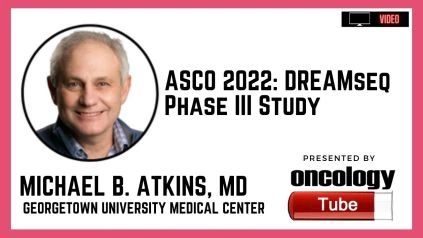Michael B. Atkins, MD, Deputy Director, Georgetown-Lombardi Comprehensive Cancer Center, William M. Scholl Professor and Vice-Chair Department of Oncology and Professor of Medicine Georgetown University Medical Center. In this video, he speaks about the ASCO 2022 Abstract – Early quality of life (QOL) and symptom analysis from the DREAMseq phase III randomized control trial of combination immunotherapy versus targeted therapy in patients (pts) with BRAF-mutant metastatic melanoma (MM) (ECOG-ACRIN EA6134).
Origins:
In patients with BRAFV600 mutant MM, combinations of immune checkpoint inhibitors (anti-PD-1/anti-CTLA-4) or BRAF/MEK-targeted treatments showed considerable clinical benefit. Until recently, there was little prospective evidence to advise the selection of initial therapy or sequencing. The DREAMseq Trial found that starting with nivolumab/ipilimumab (Nivo/Ipi) immunotherapy produced a clinically relevant 20% improvement in 2-year overall survival (OS) compared to starting with dabrafenib/trametinib (Dab/Tram) targeted therapy. The overall survival (OS) and progression-free survival (PFS) curves crossed biphasically at 10 and 6 months, respectively. Our goal is to characterize QOL trends within and between first therapies over the course of 24 weeks (wks).
Methodology:
265 patients were randomly randomized to Nivo/Ipi for up to 12 weeks, then to Nivo alone (Arm A) or Dab/Tram continuously (Arm B), and subsequently to the alternate medication at disease progression (PD). The PROMIS Profile 29 was used to assess QOL at baseline, wk 12 (end of cycle (C) 2), and wk 24. (end of C4). The Wilcoxon Signed Rank test was employed to analyze changes in treatment arms over time. The Kaplan-Meier method was used to estimate OS in patients who ceased treatment for toxicity on Arm A by C2 and those who stayed on Arm A therapy until C4. A comprehensive case study comparing QOL domain means for (C2) vs. (C4). Adverse occurrences reported by patients were also gathered.
Outcomes:
Baseline completion rates for the PROMIS-29 for Arm A (n = 108, 81.2%) and Arm B (n = 117, 88.6%) were 28.6 percent and 53.8 percent, respectively, at C4. The main causes for dropout through C4 were toxicity (35.2 percent for Arm A and 11.9 percent for Arm B) and PD (26.1 percent for Arm A and 18.6 percent for Arm B). Arm B showed statistically significant improvements in Pain Interference (-3.45, P = 0.007), Sleep (-2.11, P = 0.014), and Anxiety (-3.74, P = 0.001) from baseline to C2. These early differences had faded by C4 (mean difference = 0.73 – 1.73, all p = NS). A thorough case analysis of patients who remained on therapy until C4 (n = 157) found no significant variations in QOL between C2 and C4. Pts who stopped taking Arm A for toxicity after C2 had a similar 2-year OS as those who stayed on Arm A until C4. QOL at C2 was meaningful but underpowered (Physical Health (PH) mean difference = -3.5, p = 0.18; Arm A: discontinuing for toxicity vs. on treatment).
Observations:
According to PFS curves and toxicity profiles, Dab/Tram is related with significant improvement in overall function and less disturbance in sleep, pain, physical function, and PH than Nivo/Ipi throughout the first 12 weeks. When Arm A therapy is shifted to Nivo alone and the PFS curves intersect, these differences vanish within 24 weeks. Early QOL and therapy discontinuation due to Nivo/Ipi toxicity had no effect on 2-year OS. NCT02224781 is the clinical trial number.

